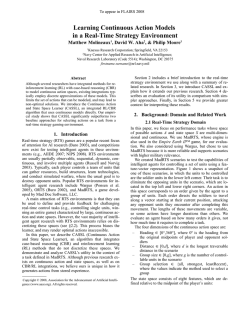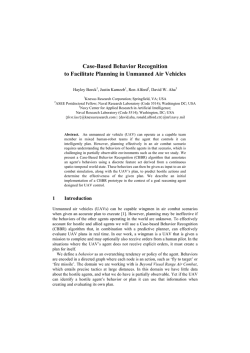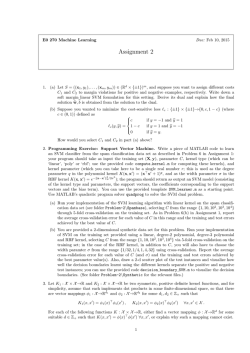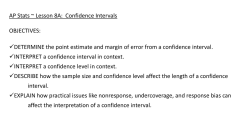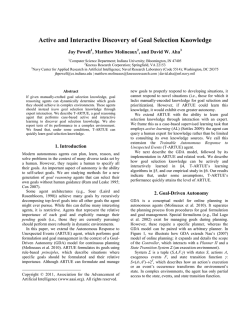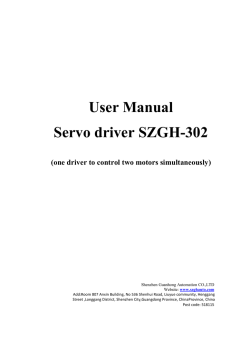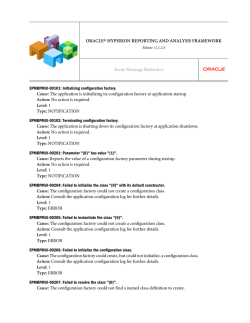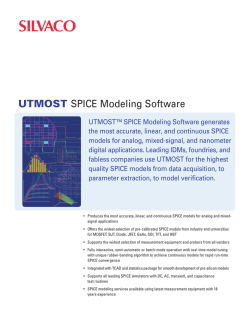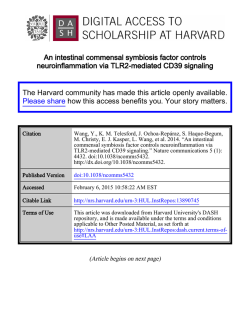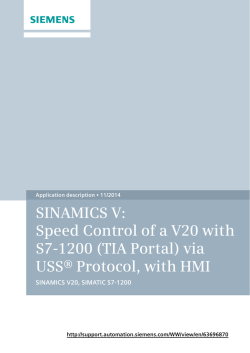
Case-Based Parameter Selection for Plans
Case-Based Parameter Selection for Plans: Coordinating Autonomous Vehicle Teams Bryan Auslander1 , Tom Apker2 , and David W. Aha3 1 Knexus Research Corporation; Springfield VA; USA 2 Exelis Inc.; Alexandria VA; USA 3 Navy Center for Applied Research in Artificial Intelligence; Naval Research Laboratory (Code 5514); Washington, DC; USA [email protected] | {thomas.apker.ctr,david.aha}@nrl.navy.mil Abstract. Executing complex plans for coordinating the behaviors of multiple heterogeneous agents often requires setting several parameters. For example, we are developing a decision aid for deploying a set of autonomous vehicles to perform situation assessment in a disaster relief operation. Our system, the Situated Decision Process (SDP), uses parameterized plans to coordinate these vehicles. However, no model exists for setting the values of these parameters. We describe a case-based reasoning solution for this problem and report on its utility in simulated scenarios, given a case library that represents only a small percentage of the problem space. We found that our agents, when executing plans generated using our case-based algorithm on problems with high uncertainty, performed significantly better than when executing plans using baseline approaches. Keywords: Case-based reasoning, parameter selection, robotic control 1 Introduction Real-world plans can be complex; they may require many parameters for coordinating multiple agents, resources, and decision points. Furthermore, multiple performance metrics may be used to assess a plan’s execution, and may involve trade offs. For example, we consider the problem of how to deploy a team of autonomous unmanned vehicles (AUVs), managed by a human operator, to conduct situation assessment in preparation for a Humanitarian Assistance/Disaster Relief (HADR) mission. The team includes a heterogeneous set of robotic platforms that vary in their capabilities. If we want to minimize vehicle energy consumption while maximizing coverage of the area surveyed, how many vehicles (and of what type) should we deploy, and how should they behave? If we’re not conservative, we may expend too many resources (vehicles or energy), reducing our capability to respond to other emergencies in the near-term. Likewise, we run the risk of poor performance if too few resources are deployed, which may have serious consequences to the effected civilians. This problem is not unique to military mission planning, as similar decisions must be made for many other types of resource-bounded tasks such as emergency first response, sports team financial management, and local government budget planning. In each case, parameterized plans may exist to solve a complex problem, but how should their parameters be set? In some situations (such as ours), this problem can be compounded when the model for mapping parameter settings to expected performance is incomplete. While such models may be acquired, this requires access to problem-solving expertise or a massive database that records problem attributes, parameter settings, and the resulting performance metrics. Unfortunately, we lack both for our task. We describe a case-based approach to solve this problem where our parameters include the number and types of AUVs to send along with algorithm specific options for surveying an area, and report on its utility in an initial empirical study. Our algorithm uses a similarity-weighted vote to set parameter values, and generates a single score for a set of performance metrics. We found that our approach generates plans that performed well in simulation studies versus baseline approaches, particularly when state uncertainty is high. We describe related work in Section 2, then propose how AUVs can support HADR missions in Section 3. In Section 4, we overview the Situated Decision Process (SDP), which defines a role for case-based parameter selection. We present our case-based algorithm in Section 5, report its application in simulated scenarios in Section 6, and discuss the results in Section 7 before concluding. 2 Related Work We focus on the problem of setting the values for multiple parameters, which are then used by a goal reasoning (GR) module to assist with multi-agent plan generation. CBR has previously been used for parameter setting. For example, Wayland [16] is a deployed case-based system used to select the parameter values for an aluminum die-casting machine. It uses a type-constrained and feature-weighted 1-nearest neighbor rule for retrieval and a rule-based approach for adaptation. Unlike our approach, Wayland’s cases do not include specific performance outcome data, nor use them for case reuse. Several CBR systems set parameter values while interacting with other reasoning modules, though to our knowledge ours is the first to supply them to a GR module for controlling multiple AUVs in coordinated plans. Weber et al. [19] uses artificial neural networks to model software programs and biological systems, resulting in a case representation of problem, solution, and outcome similar to ours. Genetic algorithms are used to learn the initial cases, which are then clustered using their solutions and given to a discriminant analysis technique to find select problem features. While they are concerned with one outcome metric we focus on a multi-objective problem, and using GAs may be infeasible in our domain due to long run times. Jin and Zhu [5] use CBR to set the initial parameter values for an injection molding process. These settings are repeatedly tested and modified by a fuzzy reasoner until all defects are eliminated, at which time a new case is stored. While not emphasized in this paper, we use CBR to repeatedly, rather than only initially, recommend parameter settings throughout plan execution. Montani [11] uses CBR to set the parameters for multiple systems, including a rule-based reasoner used to modify therapies for diabetes patients. We focus on multi-agent planning rather than rule revision, and we focus on the control of AUV teams rather than a health sciences application. Finally, Pavon et al. [15] use CBR to revise Bayesian network models for setting the control parameters of a genetic algorithm that performs root identification for geometric problems. In contrast, our CBR algorithm uses a performance-based voting procedure rather than abduction to set parameters. Jaidee et al. [3] also integrated CBR with a GR module for team coordination planning. However, they use CBR to formulate goals while we use it to set parameter values, and we focus on robotic control rather than video games. Other have studied CBR for robotics applications. For example, Likhachev et al. [7] use CBR to learn parameter settings for the behavior-based control of a ground robot in environments that change over time. Their approach learns and adapts cases, effectively searching the behavior parameter space, until good performance is obtained. While their work focuses on motion control for a single robot, we instead focus on the high-level control of robot teams. Karol et al. [6] also focus on robot team coordination (for RoboCup soccer). They use CBR to select actions that are transformed to motion control parameters. Ros et al. [18] also focus on action selection for RoboCup soccer, and use a sophisticated representation and reasoning method. Of interest to us is that each agent can behave independently and abort the plan, which is also essential in our domain because unexpected state changes could have catastrophic consequences. However, this body of research focuses on motion planning for relatively short-term behaviors, whereas we focus on longer duration plans that are monitored by a GR module. Finally, CBR has been studied for several military applications, including those involving disaster response. For example, Abi-Zeid et al. [1] studied incident prosecution, including real time support for situation assessment in search and rescue missions. Their prototype system, ASISA, uses CBR to select hierarchical information-gathering plans for situation assessment. Mu˜ noz-Avila et al.’s [12] HICAP instead uses a conversational CBR system to assist operators with refining tasks in support of noncombatant evacuation operations. SiN [13] extends their work, integrating a planner to automatically decompose tasks where feasible. However, while these systems use planning modules to support rescue operations, they do not set parameters for multiagent plans, nor focus on coordinating robot team behaviors. 3 Domain: Military HADR Operations HADR operations [14] are performed by several countries in response to events such as Hurricane Katrina (August 2005), the Haiti earthquake (2010), and Typhoon Haiyan (November 2013). Before support operations can arrive an initial wave of responders must gather required information about the impact zone (e.g., infrastructure status, suggested ingress and evacuation routes, and survivor locations). Current operations employ remotely controlled drones and human-piloted helicopters to gather this information. We instead propose deploying a heterogeneous team of AUVs with appropriate sensor platforms to automate much of this process, so as to reduce time and cost. We claim that this should enable responders to perform critical tasks more quickly for HADR operations. In this paper we focus a module of the SDP, which we are developing to assist with HADR operation. Under a human operator’s guidance, the SDP will deploy a team of heterogeneous AUVs, coordinated by a GR module to identify which goals need to be accomplished, and deploy the AUVs to best achieve them [17]. To perform this task the GR module needs to generate, compare, schedule, and dispatch plans for achieving these goals. Plans vary in their performance metrics based on resource allocation (e.g., of AUVs and their search algorithm), and selecting among them requires the GR to deliberate about their predicted performance (e.g., to maximize search area coverage and minimize energy consumption). To do this, we use a case-based algorithm to select parameter settings for the GR module, where cases associate problems with solutions (i.e., parameter settings) and their performance metrics. This enables the SDP to propose multiple solutions for a goal by optimizing on different metrics. 4 Simulating the Situated Decision Process (SDP) To provide context for our work on case-based parameter selection, we briefly describe the SDP’s modules, the simulated AUVs that it will control, their sensing models and search algorithms, and scenario performance metrics. 4.1 SDP Modules Figure 1 highlights SDP’s primary modules. It will support a Forward Air Controller (FAC) in surveying and assessing Areas of Interest (AoIs) of a HADR mission. The FAC will provide mission objectives and constraints using a HumanRobot Interface, whose GUI will permit highlighting of AoIs, important assets, and related information. These will be provided to a GR module [3], which will help to decompose the given objectives. This will result in selecting goals and conditions for synthesizing a finite state automaton to control the motions of the AUVs. Our Goal Reasoner depends on a Case-Based Parameter Selector to recommend parameter settings given geographical regions and constraints. 4.2 Simulation Platforms HADR missions begin with generating a new road map, as a common feature of disasters is the collapse of buildings or washing out of roads. We propose to use three AUV types (Figure 2), which vary in their motion properties, to perform infrastructure assessment. The number of each type corresponds to a parameter that needs to be set in HADR mission plans. From the air, the roadways that are still intact are visible to downward looking cameras, which we assume are carried at relatively high altitude (> 1000m) Fig. 1. The Situated Decision Process (SDP) (a) STUAS (b) UGV (c) MAV Fig. 2. Platforms Simulated in our Study (Acknowledgements: (A) US Marines, Shannon Arledge; (B) US Navy, Elizabeth R. Allen; (C) NASA, Sean Smith) by small tactical unmanned aircraft systems (STUAS) and at low altitudes (< 100m) by multirotor air vehicles (MAVs). From the ground, the best roadmapping sensor is a 3D omnidirectional lidar mounted on unmanned ground vehicles (UGVs). We model AUVs as nonholomonic physicomimetic agents [10]. This allows us to run them simultaneously in the MASON [9] multi-agent simulator to compare the performance of teams that vary in their numbers of each AUV type. 4.3 Sensing model Downward facing cameras and scanning lidars take measurements of the region surrounding an agent as shown in Figure 3a. For flying agents, the width d of the sampled area depends on the agent’s altitude h and the field of view of the camera α. For UGVs, d is the maximum effective range of their lidar. Both of these sensors are data-rich and information-poor, and so rather than modeling transmission of whole images, we assume they segment their sensed area into d u Δtm Agent dmin (a) Top View (b) Front View Fig. 3. Schematic of Downward-Facing Camera Image Segmented into Discrete Regions discrete grid cells dmin meters across, where dmin is half the expected width of the target signal (e.g., roads). The agent’s speed u and measurement interval ∆tm determine the minimum depth of the simulated sensor grid. We assume a square grid of d = 60m and dmin = 6m for all agents in our simulator. At each time step, where ∆tm = .1s, our simulated sensors return a Boolean grid that classifies each cell based on whether it contains the target signal. Each sensor updates an estimate of the percentage of coverage of a set of global grid cells using a one-dimensional Kalman filter, which fuses data from multiple platforms (whose sensor views overlap). A Kalman filter allows us to control the rate at which cell uncertainty can grow or be reduced with guaranteed and predictable rates of convergence of each cell to its mean value. 4.4 Area Coverage Search Algorithm We use three parameters that can affect how the AUVs search a geographical area during HADR missions, where we assume they all begin a scenario near a single, randomly selected point and follow a grazing area coverage algorithm [8]. Our first parameter determines how a simulated AUV searches. Greedy search applies a physicomimetics force to drive each agent towards the nearest “food”, here simulated by global grid cell covariance. In contrast, Segmented search, depicted in Figure 4, guides each agent towards the nearest “food” in its own Voronoi cell. Our second parameter, On Demand Recharging, is true iff the AUVs can automatically recharge themselves. Finally, if the third parameter Mobile Charger is true, then a mobile base station follows the AUVs. 4.5 Scenario Metrics Time is critical in HADR missions, both for reaching survivors and collecting information to ensure that aid is properly distributed when it arrives. However, the infrastructure damage that needs to be detected often makes resources such as electricity and fuel more precious. Thus, we define the following performance metrics to assess agent performance in our simulation studies: 1. Coverage: Percentage of the AoIs searched Fig. 4. Voronoi Partition of a Search Area among Multiple MAV Agents 2. Energy Consumption (in Joules): Total energy consumed We measure Coverage over a HADR scenario’s entire duration, which we set to 30 minutes in our empirical study because we expect HADR personnel to arrive within 30 minutes after the AUVs are deployed. Energy Consumption is calculated uniformly across fuel and battery types used to power the AUVs. In our evaluation (Section 6), we also use the compound Efficiency metric, defined as the ratio of Coverage to Energy Consumption. We found that it is a better heuristic (than the other two metrics) for guiding parameter selection. 5 Case-Based Parameter Selection We use a case-based algorithm in the SDP to select parameter settings for HADR scenarios. We describe our case representation, including a case’s recommended parameter settings, in Section 5.1. Our algorithm employs case retrieval and reuse, as described in Sections 5.2 and 5.3, but does not perform case revision or retention, which we leave for future work. 5.1 Case Representation We represent a case C = hP, S, Oi as a vector of attributes denoting a problem P , its multi-dimensional solution S, and the multi-dimensional performance outcome O recorded when executing a HADR mission plan with parameters S to the scenario summarized by P . Table 1 details this representation. The attributes of P characterize the HADR scenario and are used to define case similarity (see Section 5.2). P’s parameters are predominately focused on geometric features given the task of surveying an area. These include the number of disjoint Areas of Interest (AoIs) in the scenario, the distance between opposite corners of the (rectangular) Area of Operations (AO), the total area sizes of the AoIs, and Coverage Decay, a binary parameter indicating whether the sensor information for a grid cell decays over time and becomes obsolete (i.e., uncertainty increases). This allows us to model changes to the environment, such as when a fire spreads across grid cells. (Evaluating the effectiveness of these features versus others is left for future research.) Table 1. Case Representation used for SDP Parameter Selection Case Component Attribute Name # Disjoint AoIs AO Diagonal Distance Problem (P ) Total Area Size of AoIs Coverage Decay # STUASs # UGVs Solution (S) # MAVs Search algorithm On Demand Recharging Mobile Charger Coverage Outcome (O) Energy Consumption Value Range [1, 10] [424, 1980] [500, 1,568,000] m2 {1=true, 0=false} [0, 3] [0, 3] [0, 10] {g=greedy, s=segmented} {true, false} {true, false} [0%, 95%] [0, 8,244,000] Joules A case’s solution S contains the settings for six parameters that define how to apply the SDP to P . These include the number of each type of unmanned vehicle to deploy (i.e., STUASs, UGVs, and MAVs), the type of area coverage search algorithm to use (i.e., Greedy or Segmented), whether to use On Demand Recharging, and whether to deploy a Mobile Charger (for UGVs). Finally, the outcome attributes O are the scenario metrics described in Section 4.5. In our empirical study, our case library includes multiple cases with the same problem, but differ in their solutions, because our simulator is non-deterministic. 5.2 Case Retrieval Our parameter selection algorithm retrieves cases in two phases. In the first phase it computes the similarity of a given query (whose attributes are those listed for Problems in Table 1) with the distinct problems among cases in a library L, and retrieves those cases L0 ∈ L whose similarity exceeds a threshold t, where the similarity of a query q and a case’s problem c.P is defined as follows: sim(q, c.P ) = 1 X |qa − c.Pa | 1− , |P | amax (1) a∈P where amax is the largest possible absolute difference among two values of an attribute a. In the second phase, L0 is filtered to remove cases whose performance metrics are low. This phase is needed to remove cases whose problems may have had a poor sampling bias. Filtering is done using a function that scores the outcomes of each case c ∈ L0 relative to every other case in L0 . We score each case c by calculating a Student t-statistic4 for its Efficiency relative to some set of cases 4 We use the Student t-statistic because the population statistics of our nondeterministic scenarios are unknown, and we have verified that Coverage and Energy Consumption are both normally distributed. Algorithm 1: Case Reuse Algorithm for Setting Parameter Values Inputs: Query q, Cases Nq Returns: Solution[] // A vector of parameter settings for q Legend: Nq // q’s k-Neighborhood of cases s // A parameter among those in q’s predicted solution S V otes[] // Summed weighted scores, indexed by parameter SumW eights[] // Summed weights, indexed by parameter SetParameters(q, Nq ) = foreach s ∈ S do V otes[s] = SumW eights[s] = 0; foreach c ∈ Nq do foreach s ∈ c.S do weight = sim(q,c.P ); V otes[s] += weight × score(c, Nq ); SumW eights[s] += weight; foreach s ∈ c.S do // Compute value for parameter s with the highest weighted vote Solution[s] = maxParamValue(V otes[s]/SumW eights[s]); return Solution[]; C as follows: score(c, C) = ce − C e , s (2) where ce is the efficiency of case c, C e is the mean efficiency of all cases in C, and s is the sample deviation of C. For each case c ∈ L0 , we compute its score(c,L0 ). For each subset of cases 0 Lp ⊂ L0 with problem p, we identify its n% most Efficient cases and compute their mean, denoted by mean(L0 , p, n). We then rank these mean values across all problems p represented in L0 , identify the problems P 0 with the k highest values of mean(L0 , p, n), and return all cases with a problem p ∈ P 0 . This yields, for query q, a neighborhood of retrieved (and filtered) cases Nq . 5.3 Case Reuse SDP uses Algorithm 1 for case reuse. It computes a similarity-weighted vote among the retrieved cases Nq , where a vote of a case c ∈ Nq is the product of its problem’s similarity to q and its score(c,Nq ) as defined in Equation 2. Our HADR sceanrio simulator is non-deterministic. Thus, the metrics computed for a given hproblem,solutioni pair can vary each time a scenario is executed. To account for this we compute these metrics using their mean values across a set of scenario executions. Given a query q and a set of cases Nq , Algorithm 1 computes a score for each case c ∈ Nq (the k-Neighborhood of q) and then computes the weighted vote of each parameter in q’s solution vector S. Our algorithm allows for all cases in Nq to contribute votes to the adapted solution, and assumes that the parameters are independent. It weights each vote by the similarity of c.P to q, giving more (normalized) weight to cases that are more similar to query q. Finally, it returns a solution (i.e., a vector of parameter settings). 6 Empirical Study We empirically tested four research hypotheses: H1 Solutions obtained using problem knowledge can outperform random solutions. H2 No single solution performs optimally on all problems. H3 Using a case-based approach to set parameters yields solutions that perform well in comparison to a known good solution. H4 Case adaptation increases performance metrics. In the following sections we describe the metrics, simulation data, empirical method, algorithms tested, the results, and their analysis. 6.1 Metrics We initially planned to use the (raw) outcome metrics in O listed in Table 1, namely Coverage and Energy Consumption. However, neither metric alone provides comprehensive insights for the results. This motivated us to introduce Efficiency (Section 4.5), which we use for results analysis. 6.2 Simulation Data We conducted our study using MASON [9], a discrete-event multiagent simulator that models all physics behaviors and physicomimetics control. A problem scenario in MASON is defined by the problem attributes P (see Table 1), the locations and sizes of the AoIs, and the AUVs’ starting locations. (We did not include these latter attributes in P due, in part, to their high variance.) Running MASON scenarios also requires setting the parameters in S (e.g., the number of AUVs per platform type, the type of area search algorithm to use). Running a parameterized MASON scenario yields the set of outcomes in O. MASON is non-deterministic; these outcomes can vary each time it runs a parameterized scenario because it executes the actions of multiple agents in a random order. To generate the case library L for our experiments, we created a problem scenario generator that outputs random scenarios (according to a uniform distribution) over the attributes for problems and solutions, using the ranges shown in Table 1. We used it to generate 20 problem scenarios and paired each with 100 solution vectors to yield the P and S values for 2000 cases. We then executed each hScenario,Solutioni pair in MASON 10 times, and recorded the average values of the outcome metrics (O) with each case. Table 2. Test Scenario Problems Problem # Disjoint AoIs AO Diagonal Distance AoIs’ Area Coverage Decay 1 1 1621 259972 2 7 1553 396580 No 3 6 1400 375275 4 6 1001 69279 5 4 1332 130684 6 10 1451 285652 7 5 636 14452 Yes 8 3 1773 197925 9 10 1222 165494 10 3 1833 194512 6.3 Empirical Method We tested our CBR algorithms (Section 6.4) using a partial cross-validation strategy. In particular, we selected the first 10 problem scenarios (see Table 2) among the 20 generated, and performed leave-one-out testing. That is, when we tested a problem scenario pi , we temporarily removed the 100 cases in L with problem pi for testing, leaving 1900 cases in L. We repeated this cross-validation 10 times to generate the data for our analyses. The time required to generate L was four days, even after parallelizing the 10 trials per problem and dividing the problems among two multi-cpu machines. Thus, time constraints prevented us from running a complete leave-one-out test on all 20 problems, which we leave for future work. 6.4 Algorithms Tested We tested two CBR algorithms that vary in whether they perform case adaptation/reuse. They both apply the case retrieval algorithm described in Section 5.2, where we set k = 3, n = 20% and t = 75%. (Values were not optimized). CBRN (Non-adapted) This retrieves Nq , selects a case c ∈ Nq that has the maximum score(c,Nq ), and executes MASON using the solution vector c.S. CBRA (Adapted) After case retrieval, this applies Algorithm 1 to q and Nq . It outputs solution vector S, which is given to MASON to execute. We also included the following three baselines in our experiments: Random Mean (R) This does not require simulation. Instead, for a given scenario, it locates the 100 cases in L whose problem P matches the scenario, and yields the mean value of their outcome metrics. Best Overall (O) This evaluates how well a single good solution performs across all problems. It finds the case c ∈ L whose solution c.S has the highest score(c,L) and applies it to every problem in the test set. Problem 01 ● Problem 02 Problem 03 ● ● ● ● ● 0.8 ● Problem 05 Problem 06 Problem 07 Problem 08 Problem 09 Problem 10 ● ● ● ● ● ● ● ● Coverage Problem 04 ● ● ● 0.6 ● ● ● ● ● ● ● ● ● 0.4 ● ● ● ● ● ● ● ● ● ● ● ● ● ● ● ● ● ● ● ● ● ● 0.2 ● ● ● ● A N O S A N O S A N O S A N O S A N O S A N O S A N O S A N O S A N O S A N O S Approach Problem 01 Problem 02 Problem 03 Problem 04 Problem 05 Problem 06 Problem 07 Problem 08 Problem 09 Problem 10 ● Energy Consumption ● ● 2000000 ● ● 1500000 ● ● ● ● ● ● ● ● ● ● ● ● ● ● N O ● ● ● ● ● ● ● ● 1000000 ● ● ● ● ● ● ● ● 500000 ● A N O S ● A N O S A N O S A ● ● S ● ● A N O S ● ● A N O S ● ● A N O S ● ● A N O S ● ● A N ● O S A N O S Approach Fig. 5. Performance of CBRA (A), CBRN (N), O, and S on Coverage, where higher values are preferred, and Energy Consumption, where lower values are preferred Best Sampled (S) This is designed to produce a good known solution for any query. It locates the 100 cases L0 ⊂ L whose problem matches the given scenario, finds the case c ∈ L0 with highest score(c, L0 ), and returns its outcome metrics c.O. 6.5 Results and Analysis H1: Figure 5 displays plots for Coverage and Energy Consumption for the test problems. Using a one-tailed t-test, we found that R consistently recorded significantly lower Efficiency (not shown for space reasons) than the other algorithms, which supports H1. For Coverage, S performed significantly better on 6 scenarios, O 9 times, CBRN 4 times, and CBRA 6 times. For Energy Consumption, these algorithms significantly outperformed R for all scenarios (except problem 4 for CBRN and O). Given this, we will ignore R for the rest of this section. H2: We expected that O would be consistently outperformed by, or perform simmilarly to, the remaining algorithms for the 9 test problems (O’s solution came from a case with Problem 1, which we excluded from testing). Comparing Efficiency, S significantly outperformed O on 8 test problems, while CBRN (CBRA ) significantly outperformed O on 4 of the 6 problems in which Coverage Decay exists (primarily due to lower Energy Consumption). These results support this hypothesis (i.e., that one solution does not perform well across all test problems and tailoring of solutions is preferable), particularly for when Coverage Decay (i.e., higher state uncertainty) exists. H3: The results support this hypothesis, especially for Coverage Decay problems. For example, when comparing Efficiency CBRA significantly outperformed S on Table 3. Solutions generated by algorithms S, CBRN (N), and CBRA (A) for problems 1-10 (where t for Greedy indicates that Greedy search was used, Recharging means On Demand Recharging, and Mobile C means a Mobile Charger was used) P 1 2 3 4 5 6 7 8 9 10 S 0 0 0 1 1 1 2 2 0 0 #MAVs N A 2 2 1 0 2 2 2 2 0 0 0 0 0 0 0 0 0 0 1 0 S 0 0 0 1 0 0 0 0 0 0 #UGVs N A 0 3 1 3 0 3 0 0 0 0 0 0 0 0 0 0 0 0 0 0 #STUASs S N A 1 3 3 1 3 3 2 3 3 3 3 3 2 1 1 2 1 1 1 1 1 3 1 1 1 1 1 2 1 1 S t f f t f f t f t f Greedy N A f f t t f f f f t t t f t f t t t t f f Recharging S N A t t t t t t t t t t t t t t t t t t t t t t t t f t t t t t S f f f t f f f f t f Mobile C N A f f t f f f f f f f f f f f f f f f f f problems {6,7,9,10} while CBRN outperformed S on {5,6,7,9}. We discuss this further in Section 7. H4: We analyzed whether CBRA outperformed CBRN , which seems to be indicated by Figure 5. For Coverage, CBRA significantly outperforms CBRN on 4 problems, though sometimes at the expense of Energy Consumption (e.g., for problem 3). However, while the graphs suggest some advantages to case reuse, the significance tests are inconclusive. 7 Discussion The results are challenging to analyze because this is a multi-objective problem. Although Efficiency combines them, it treats both outcome metrics equally, independently of whether this is preferable. The CBR algorithms performed well on Coverage, but were mediocre on Energy Consumption compared to S on problems 1-4, which are not Coverage Decay problems. However, while S is supposed to be a good solution, the plans generated by the CBR algorithms perform comparably without cheating (i.e., training on test problems). Table 3 displays the solutions generated by S, CBRN , and CBRA for each problem. (Baseline O always chose 2 MAVs, 0 UGVs, 3 STUASs, Segmented search, On Demand Recharging, and no Mobile Charger.) The large variance in Coverage (Figure 5) is partially caused by solutions that use few STUAS (Table 3). This is due in part to a physics model that permits STUAS, in some conditions, to depart (i.e., fly out of) an AoI. However, Coverage variations are much smaller for problems {6,7,9} than problems {5,8}, even though they all use only one STUAS. This is because the latter problems have fewer disjoint AoIs, which may reduce the frequency with which STUAS depart the map. We will address this issue in future work. For Coverage Decay problems, 95% Coverage becomes nearly impossible to obtain, and the CBR algorithms converge to using one STUAS to increase Efficiency (i.e., low Energy Consumption and large Coverage). Operating multiple AUVs yields diminishing benefits (i.e., marginally larger Coverage at a higher Energy Consumption), although an operator may prefer higher Coverage. We will further explore what metrics to use in future work. 8 Conclusion To our knowledge, this is the first study that uses CBR to set parameters that control the behavior of a heterogeneous AUV team (here, to perform situation assessment for HADR missions). Our simulation study showed that our case-based algorithm can perform well on this task (i.e., outperforms a random approach as well as the parameter values found to perform best for any scenario, and performs comparably to the best known solution for a given problem scenario). While case adaptation tends to improve performance, the increases are not significant. Our simulation models only some of the real-world environment’s characteristics (e.g., it ignores wind, ground cover, and vehicle overhead costs), which could impact our results. For example, substantial ground cover could degrade the data collected by a STUAS, and increase reliance on the other two platforms. Adding these parameters would make pre-calculation of solutions for the entire problem space infeasible, and strongly motivate the need for case retention. Our case reuse algorithm makes a strong independence assumption and is sensitive to small training sets. We will study other approaches for adapting cases such as using stretched neighborhoods for each dimension [4]. We will also study methods for seeding the case base with good solutions learned from multiobjective optimization functions. Although this type of optimization has been used previously (e.g., [2]), we propose to use it to seed the case base rather than use cases to seed further multi-objective searches. Finally, we will test the SDP for its ability to help an operator guide a team of AUVs in outdoor field tests under controlled conditions. We have scheduled such tests, with increasingly challenging scenarios, during the next three years. Acknowledgements The research described in this paper was funded by OSD ASD (R&E). We also thank Michael Floyd and the reviewers for their comments on an earlier draft. References 1. Abi-Zeid, I., Yang, Q., Lamontagne, L.: Is CBR applicable to the coordination of search and rescue operations? A feasibility study. In: Proceedings of the Third International Conference on Case-Based Reasoning. pp. 358–371. Springer (1999) 2. Cobb, C., Zhang, Y., Agogino, A.: Mems design synthesis: Integrating case-based reasoning and multi-objective genetic algorithms. Proceedings of SPIE 6414 (2006) 3. Jaidee, U., Mu˜ noz-Avila, H., Aha, D.: Case-based goal-driven coordination of multiple learning agents. In: Proceedings of the Twenty-First International Conference on Case-Based Reasoning. pp. 164–178. Springer (2013) 4. Jalali, V., Leake, D.: An ensemble approach to instance-based regression using stretched neighborhoods. In: Proceedings of the Twenty-Sixth International Florida Artificial Intelligence Research Society Conference (2013) 5. Jin, X., Zhu, X.: Process parameter setting using case-based and fuzzy reasoning for injection molding. In: Proceedings of the Third World Congress on Intelligent Control and Automation. pp. 335–340. IEEE (2000) 6. Karol, A., Nebel, B., Stanton, C., Williams, M.A.: Case-based game play in the robocup four-legged league: Part I The theoretical model. In: RoboCup 2003: Robot Soccer World Cup VII. pp. 739–747 (2003) 7. Likhachev, M., Kaess, M., Arkin, R.: Learning behavioral parameterization using spatio-temporal case-based reasoning. In: Proceedings of the International Conference on Robotics and Automation. vol. 2, pp. 1282–1289. IEEE (2002) 8. Liu, S.Y., Hedrick, J.: The application of domain of danger in autonomous agent team and its effect on exploration efficiency. In: Proceedings of the 2011 IEEE American Control Conference. pp. 4111–4116. San Francisco, CA (2011) 9. Luke, S., Cioffi-Revilla, C., Panait, L., Sullivan, K., Balan, G.: Mason: A multiagent simulation environment. Simulation 81(7), 517–527 (2005) 10. Martinson, E., Apker, T., Bugajska, M.: Optimizing a reconfigurable robotic microphone array. In: International Conference on Intelligent Robots and Systems. pp. 125–130. IEEE (2011) 11. Montani, S.: Exploring new roles for case-based reasoning in heterogeneous ai systems for medical decision support. Applied Intelligence 28, 275–285 (2008) 12. Mu˜ noz-Avila, H., Aha, D., Breslow, L., Nau, D.: HICAP: An interactive case-based planning architecture and its application to noncombatant evacuation operations. In: Proceedings of the Ninth National Conference on Innovative Applications of Artificial Intelligence. pp. 879–885. AAAI Press (1999) 13. Mu˜ noz-Avila, H., Aha, D., Nau, D., Weber, R., Breslow, L., Yaman, F.: SiN: Integrating case-based reasoning with task decomposition. In: Proceedings of the Seventeenth International Joint Conference on Artificial Intelligence. pp. 999–1004. Morgan Kaufmann (2001) 14. O’Connor, C.: Foreign humanitarian assistance and disaster-relief operations: Lessons learned and best practices. In: Naval War College Review. vol. 65 (2012) 15. Pav´ on, R., D´ıaz, F., Laza, R., Luz´ on, V.: Automatic parameter tuning with a Bayesian case-based reasoning system: A case study. Expert Systems with Applications 36, 3407–3420 (2009) 16. Price, C., Pegler, I.: Deciding parameter values with case-based reasoning. In: Proceedings of the First International Conference on Case-Based Reasoning. pp. 119–133. Springer (1995) 17. Roberts, M., Vattam, S., Alford, R., Auslander, B., Karneeb, J., Molineaux, M., Apker, T., Wilson, M., McMahon, J., Aha, D.: Iterative goal refinement for robotics. In: ICAPS Workshop on Planning and Robotics (2014) 18. Ros, R., Arcos, J., Lopez de Mantaras, R., Veloso, M.: A case-based approach for coordinated action selection in robot soccer. Artificial Intelligence 173, 1014–1039 (2009) 19. Weber, R., Proctor, J.M., Waldstein, I., Kriete, A.: CBR for modeling complex systems. In: Proceedings of the Sixth International Conference on Case-Based Reasoning, pp. 625–639. Springer (2005)
© Copyright 2026
